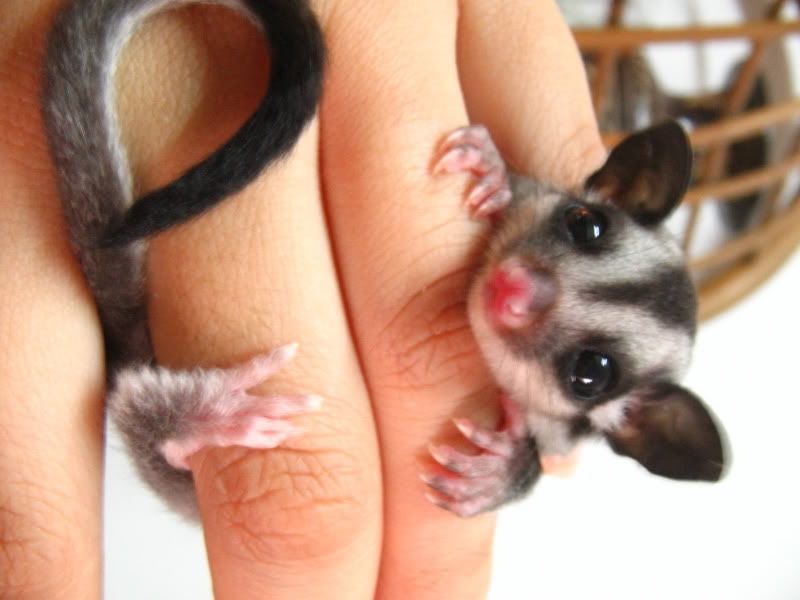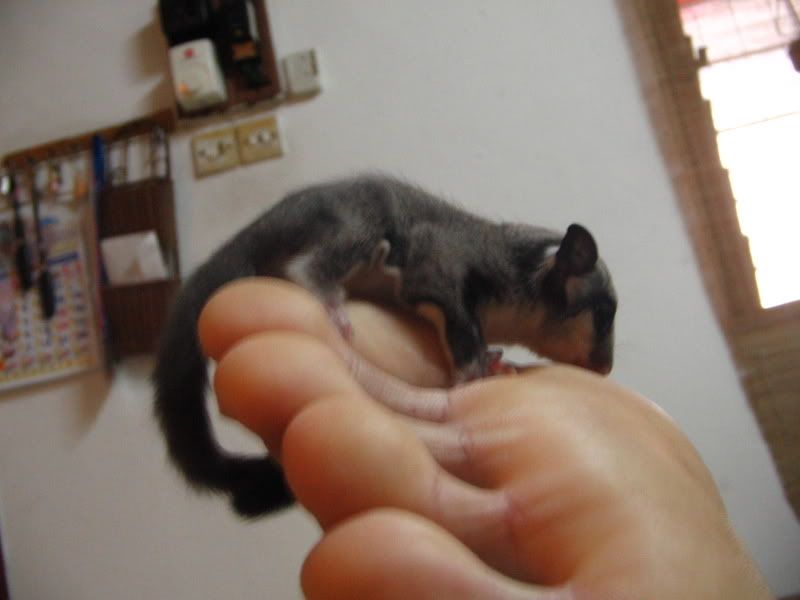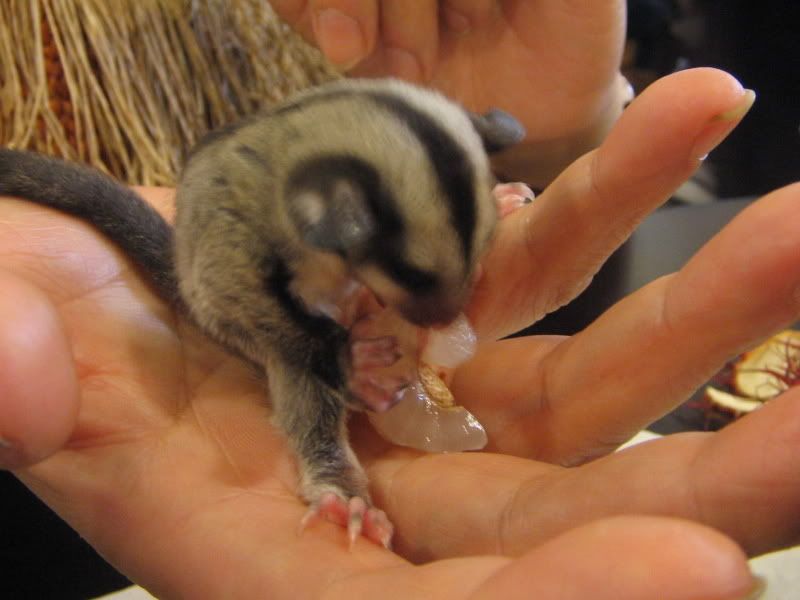Bonding and SocializingThe first day in a new home for your glider will be quite scary. Once you've brought home your glider, leave it in its cage for a day so that it can get familiar with his new home. Playing with the new glider immediately will cause stress so it's best to leave the glider alone for awhile. Keep the cage in a dark and quiet place. You can even place a cloth or a t-shirt over the cage so that the glider will feel more secure.

I personally find that the best way to bond with your glider is to keep it close to your body. During the day, keep them in your shirt pocket or in a pouch that you can hang from your neck. The glider will get accustomed to your smell. The breathing and warmth is also comforting to them. Bonding with a glider doesn't mean playing with the glider all the time. Gliders can get stressed when overplayed with. In the late evening or early morning (gliders are nocturnal meaning that they are active during the night), spend some time to socialise with your glider by letting it explore your body, hang it upside down and hand feed it.
Tame and bonded gliders can respond to their name and follow simple commands like "come here" or "let go" or "NO!" when commanded by their owners. They will also be very clingy and loyal towards their owners.

There are 2 types of gliders in the market. Baby gliders and adult gliders. Many people are excited over the cheaper prices of adult gliders but they do not realise that most of the adult gliders sold are wild gliders that has not been tamed from young and can be very very difficult to tame. Instead of a pocket pet that snuggles up to you, you'll get a scratchy, crabby and bitey glider. When you're considering sugar gliders as pets, make sure that they are either tamed or babies. Babies bond much better with their owners and they are much easier to tame. Even if they do bite and scratch at first, it won't be painful.
It easy to carry gliders around even when you go out to public places. They will snuggle in their pouches or shirt pockets. Use pouches that are made out of breatheable fabric.

 Must Sugar Gliders be Kept in a Pair?
Must Sugar Gliders be Kept in a Pair?There are many cases against keeping sugar gliders along due to their nature in living in a colony of gliders. Keeping gliders in at least a pair is recommended because many people cannot give half of their time to their gliders.
Gliders can die from loneliness so there is no way to keep a glider alone locked up in the cage for most of its life.
Gliders can certainly be kept alone if the owner is able to spend tons of time with the glider (we're talking about at least 12 hours). This is easier than it's been made out to be. Gliders kept singly will only require 1 hour of play-time but snuggling up to their owner, seeing them every hour or two, receiving strokes murmurs from their owners is what keeps the glider from being lonely. Being pocket pets, gliders can be brought to almost everywhere so they're easy enough to keep by your side for 12 hours or more.
Glider ScentMale sugar gliders have a scent gland in the middle of the top of their head, which causes the typical bald spot in the center of the wide part of the black stripe there. Another gland is located in the middle of their chest. A third gland, an anal one, is shared by males and females alike. The females also have a scent gland in their pouch.

The male's forehead and chest glands are used in marking his territory and his mates with his scent. Gliders produce at least three distinct odors. One is a sweet, flowery smell; another I don't know how to describe, but it is not really offensive. It can get relatively strong at times, when they are breeding, but after a few days it dies away again. The third is a pungent smell that is produced by the anal gland when a glider is afraid.
Gliders use urine to mark their territory, so you will need to clean their cages and furnishings periodically. Otherwise though, they are very clean little animals
Glider NutritionIn the wild Glider diet consists of insect and plant exudates such as nectar, pollen, tree sap, manna, honeydew and in some species fruit and seeds. Protein is supplied through the consumption of insects, moths, beetles, pollen and occasional small vertebrates. It is very difficult to duplicate this exact diet because the exact plants are not commonly availble in stores. However, there have been diets that have been used for several years that seam to provide all the nutritional value required for healthy gliders.
Gliders take variety food. The ideal diet for them would be a glider mix food (with various glider-safe ingredients), fruits/vegetables and pesticide free insects.

Many gliders in captivity suffer from malnutrition because there are not many staple food that are well-balanced in the market and many keepers are misinformed on what to feed gliders.
Best nutrition and most widely accepted foods apple (and apple juice), banana, blueberry, cantaloupe, carrot, cherry, chicken (boiled without skin), coconut, cucumber, eggs (hard boiled or scrambled no added butter or oil), fig, grape, honey, honeydew, insects (farm raised to be used as food such as crickets and meal worms), kiwi, mandarins, mango, melon, papaya, Peach, pear, pineapple, plum, prune, raisin, raspberry, squash, strawberry, sweet potato (not cooked), wheat Germ
Good Foods but should not be used every day for long periodsbeans, beets, broccoli, cauliflower, corn, cottage cheese, grapefruit, greens (mustard, kale, collard, celery, stalks, turnip), kale, nectar, oranges, parsley, peas, spinach, turnips, yogurt
 Foods to avoid
Foods to avoid caffeine (coffee, tea, soda, chocolate etc..), canned foods fruit or meat (most contain added salt and sugar), canned fruit, cheese May cause intestinal stoppage or "binding" leading to constipation, chives, chocolate It causes a toxic chemical reaction in most animals, fat (any food with high or added fat), Fire Fly (lightning bugs) or any other insect that was not farmed raised for food, fried foods, garlic, iceberg lettuce (non nutritional), insects that are wild caught, keels, milk, millet (or other very small seeds), nuts (possible exception of a uncooked, unsalted penult for very rare extra special treats), onions, phosphorus stay away from foods high in phosphorus. use a calcium that does not contain phosphorous., pinkys (although very nutritious we choose not to feed pinkies because of a few items that suggest feeding pinkies may increase the possibility of mothers eating their joeys.), pits (from fruit), processed meat, raw eggs, raw meat (except for live insects), rhubarb, salt (any food with added salt), scallions, sugar (foods with added sugar), sugar (refined sugar, table sugar), tofu / soy products (Even though tofu has been thought of as the perfect protein you may want to avoid this or use it very limited because of several recent articles which suggest "The facts are stated clearly - soy products in the diet of the studied animals is believed to have harmful effects on the body's digestive and reproductive systems."Why take the risk of Tofu when there are many other forms of protein
Reasons1. Garlic, onions, scallions, chives, leeks, ramsons, (any member of the Allium genus).
These vegetables have been known to cause anemia in many domestic animal species.
Warning: Some baby foods contain onion or garlic powder. To be safe, always throughly scan the ingredients of prepared baby foods before purchase.
2. Millet
This popular item for birds is a definate no-no for Sugar Gliders. These small granules will likely cause intestinal impaction if too many are consumed.
3. Fruit Seeds
The seeds and pits of various fruits are sources of extremely potent toxins. To be safe, throughly check all food dishes before dinner-time to ensure you haven't mistakenly included any seeds, pits, stones, etc.
4. Nuts
With the exception of the occasional Brazil nut, avoid offering nuts. Nuts are high in fat and also oxalic acid, which interferes with calcium absorption. Nuts have also been linked to other health problems in Sugar Gliders.
Any benefits nuts have to offer can be derived from the rest of the diet, provided it is well-balanced.
5. Avocado
Although many Sugar Glider owners offer avocado flesh, this fruit is extremely high in fat and contains toxins known as cardiac glycosides. I recommend never offering this fruit to your gliders.
6. Citrus fruits (oranges, grapefruits, lemons, etc.)
Although offering citrus fruits on occasion will benefit your glider's health, overdoing it will result in diarrhea (which leads to dehydration and a host of other health problems).
7. Sunflower Seeds
Do not offer these seeds in excess. They are loaded with fat and may contribute to intestinal problems.
8. Peas, peanuts, and some plants belonging to the family Cruciferae (Brassicaceae) --- which include broccoli, kale, cauliflower, turnips, mustard, and Brussels sprouts --- have been known to repress the production of thyroid hormone in animals. Do not completely avoid offering these items (although peanuts should be avoided for other reasons as well); just limit your offering of them, and be aware of their potential interactions within the body.
9. Spinach, parsley, rhubarb, beets (and their greens), Swiss chard, mustard, kale, collards, celery stalks, turnip greens, many beans, and plants of the genus Rumex (sorrel, dock) contain oxalic acid, a chemical that binds with calcium and renders it unavailable to the body. (When offering leafy greens, try to stick with Romaine lettuce or other selections not listed above.)
10. Corn
This sweet vegetable is relished by most Sugar Gliders, but do not offer this as a staple, because it is loaded with phosphorous. An excess of this mineral in the diet may compromise proper calcium absorption. A few kernels or a small cob once and a while is fine.
11. Milk Products (yogurt, cottage cheese, etc.)
A Sugar Glider can tolertate lactose in its diet, but some individuals will be less tolerant than others. The keys are moderation and individual attention. Do not feed straight milk or overfeed lactose-rich foods. Observe what each of your gliders eats each night, and take note of how their bodies react to it. Even though it will be difficult to keep track of which gliders are producing which bowel movements, you can figure this out by close observation, or by temporarily separating an individual you suspect to be having a problem for a few hours.
Health ProblemsHind Leg Paralysis - caused by inadequate calcium absorption due to poor diet (low calcium, high phosphate, low Vitamin D) leads the glider's body to produce increased parathyroid hormone, which removes calcium from the bones It is one of the most prevalent dietary problems in gliders and is totally preventable in all cases except where a glider may have a genetic defect making the glider not able to metabolize calcium correctly. You will notice a glider back legs getting week and eventually the glider will be dragging himself by his front legs. This condition can successfully be treated if noticed early and immediately treatment is started. Your vet may want to (and should) rule out possible other causes by x-ray like broken bones.
Dehydration / Diarrhea - Dehydration is simply a symptom to many other illnesses. A glider can die in as little as 10 hours in a hot environment from dehydration. Diarrhea is another symptom of many other illnesses and is it self a cause of dehydration. By pulling up the skin at the glider's shoulders and observing if the skin stays up or goes down very slowly suggest strongly that the glider is dehydrated. Mild dehydration for a known cause (like empty water bottle) can be treated simply by providing fresh water.
Stress / Isolation / No Socialization - Gliders cannot handle stress very well unless they are well bonded and receive a lot of security and comfort from their owner or cage mate. Environment changes like going to a new home wear there are different sundering, different smells and most likely different food can all cause stress. New people, new cage mates, other animals, children, and different sounds are among just some of the things that can cause stress. While stress may not be the same as a virus it can however cause the gliders immune system to weaken opening up additional possible avenues of getting sick. Further Gliders are very social animals and without other gliders or humans to have a social interaction with they will end up being stressed or depresses. The lack of socialization can actually lead to manifest in physical symptoms and severer depression. Some symptoms of stress are sudden change in attitude or behavior, intestinal problems. Cage circling, biting, loss of hair, self-mutilation, and repeated cage movements over and over again. Although I have never seen it in any of my Gliders, apparently self-mutilation has increased quite a bit and become a big concern among several Glider owners.
This post has been edited by smellyocheese: Aug 2 2006, 10:48 PM 








 Aug 2 2006, 02:36 PM, updated 20y ago
Aug 2 2006, 02:36 PM, updated 20y ago
 Quote
Quote













 0.0173sec
0.0173sec
 0.33
0.33
 6 queries
6 queries
 GZIP Disabled
GZIP Disabled